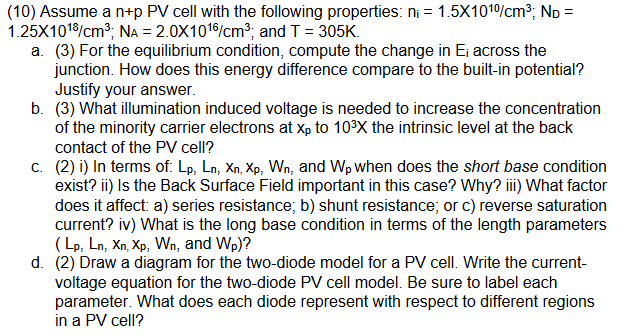Home /
Expert Answers /
Electrical Engineering /
10-assume-a-n-p-pv-cell-with-the-following-properties-ni-1-51010-cm3-nd-1-251018-cm3-pa920
(Solved): (10) Assume a n+p PV cell with the following properties: ni=1.51010/cm3;ND= 1.251018/cm3 ...
(10) Assume a PV cell with the following properties: ; and . a. (3) For the equilibrium condition, compute the change in across the junction. How does this energy difference compare to the built-in potential? Justify your answer. b. (3) What illumination induced voltage is needed to increase the concentration of the minority carrier electrons at to the intrinsic level at the back contact of the PV cell? c. (2) i) In terms of: , and when does the short base condition exist? ii) Is the Back Surface Field important in this case? Why? iii) What factor does it affect: a) series resistance; b) shunt resistance; or c) reverse saturation current? iv) What is the long base condition in terms of the length parameters , and )? d. (2) Draw a diagram for the two-diode model for a PV cell. Write the currentvoltage equation for the two-diode PV cell model. Be sure to label each parameter. What does each diode represent with respect to different regions in a PV cell?
Expert Answer
a. For the equilibrium condition, the energy difference across the junction is given by: ?E_i = (k_B T/q) ln(N_D/n_i) where k_B is Boltzmann's constant, T is the temperature, q is the electronic charge, N_D is the donor concentration, and n_i is the intrinsic carrier concentration. Plugging in the values given, we get: ?E_i = (1.38×10^-23 J/K × 305 K / 1.60×10^-19 C) ln(1.25×10^18 / 1.5×10^10) ? 0.795 eV The built-in potential can be calculated from the energy difference using the relation: V_bi = ?E_i / q which gives: V_bi ? 0.795 eV / 1.60×10^-19 C ? 0.496 V The energy difference across the junction is larger than the built-in potential, which means that some external energy is needed to overcome the potential barrier and generate a photocurrent. Please refer to the solution in this step.
